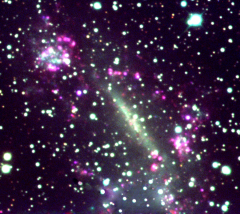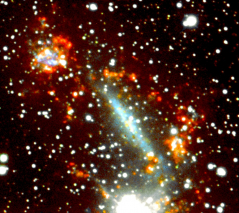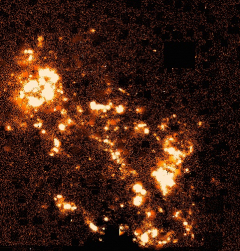Media
Collaboration of HKU and University of Manchester astrophysicists leads to discovery of a spectacular galaxy collision lurking behind the Milky Way
-- Celestial fireworks mark nearest galaxy “train-wreck”
17 Aug 2015
A spectacular galaxy collision has been discovered lurking behind the Milky Way. The closest such system ever found, the discovery was announced today by a team of astronomers led by Professor Quentin Parker at the University of Hong-Kong (HKU) and Professor Albert Zijlstra at the University of Manchester, U.K.. The scientists published their results in the Monthly Notices of the Royal Astronomical Society.
The ring is 30 million light years away, which makes it a relatively nearby galaxy. It has been dubbed "Kathryn's wheel" both after the famous fireworks that it resembles, but also after the wife of the paper's second author Professor Albert Zijlstra.
Such systems are very rare and arise from "bulls-eye" collisions between two galaxies of similar mass. Shock-waves from the collision compress reservoirs of gas in each galaxy and trigger the formation of new stars. This creates a spectacular ring of intense emission, and lights up the system like a Catherine wheel on bonfire night.
Galaxies grow through collisions but it is rare to catch one in the process, and extremely rare to see a bull's-eye collision in progress. Fewer than 20 systems with complete rings are known.
Kathryn's Wheel was discovered during a special wide-field survey of the Southern Milky Way undertaken with the UK Schmidt Telescope in Australia. It used a narrow wavelength optical region centred on the so-called red "H-alpha" emission line of Hydrogen gas. This rare jewel was uncovered during a search of the survey images for the remnants of dying stars in our Milky Way. The authors were very surprised to also find this spectacular cosmic ring, sitting remotely behind the dust and gas of the Milky Way in the constellation of Ara (the Altar).
The newly discovered ring galaxy is seven times closer than anything found before, and forty times closer than the famous 'Cartwheel' galaxy. The ring is located behind a dense star field and close to a very bright foreground star, which is why it had not been noted before. There are very few other galaxies in its neighbourhood: the odds of a collision in such an empty region of space are very low.
Professor Parker said: "Not only is this system visually stunning, but it's close enough to be an ideal target for detailed study. The ring is also quite low in mass - a few thousand million Suns or less than 1% of the Milky Way - so our discovery shows that collision rings can form around much smaller galaxies than we thought."
Professor Zijlstra added: "It is not often that you get to name any objects in the sky. But I think Kathryn's Wheel is particularly fitting, resembling as it does a firework and continuing the tradition of naming objects after loved ones."
Smaller galaxies are more common than large ones, implying that collisional rings could be ten times as common as previously thought. The authors intend more detailed studies on larger telescopes since the system is currently the only one of its kind close enough to permit study in exquisite detail.
Media contacts:
Dr Sam Lindsay, Royal Astronomical Society (Tel: +44 (0)20 7734 3307/ sl@ras.org.uk)
Dr Morgan Hollis, Royal Astronomical Society (Tel: +44 (0)20 7734 3307/ mh@ras.org.uk)
Ms Rhea Leung, Communication and Public Affairs Office, the University of Hong Kong (Tel: 2857 8555/ 9022 7446; email: rhea.leung@hku.hk)
Science contacts:
Professor Quentin Parker, the University of Hong Kong (mobile: +852 5669 9166, e-mail: quentinp@hku.hk)
(Professor Parker is currently in South Africa on an observing mission. He can be contacted via this mobile number: +27 791900475)
Professor Albert Zijlstra, University of Manchester (mobile: +44 7780747869, e-mail: a.zijlstra@manchester.ac.uk)
Further information
The new work has just been published in "Monthly Notices of the Royal Astronomical Society, Oxford University Press". A copy of the paper is available at http://mnras.oxfordjournals.org/lookup/doi/10.1093/mnras/stv1432.
Team:
The University of Hong Kong: Professor Q.A. Parker (quentinp@hku.hk), Dr. D.J. Frew (djfrew@hku.hk) and Dr. I.Bojicic (ibojicic@hku.hk)
The University of Manchester: Professor Albert Zijlstra (a.zijlstra@manchester.ac.uk) and Dr George Bendo (george.bendo@manchester.ac.uk; Office: +44 161 27 54258 )
University of Western Sydney/Macquarie University: Dr. Milorad Stupar (milorad.stupar@mq.edu.au)
University of the Western Cape: Dr. Michele Cluver (mcluver@ast.uct.ac.za)
Notes for editors
The Royal Astronomical Society (RAS, www.ras.org.uk), founded in 1820, encourages and promotes the study of astronomy, solar-system science, geophysics and closely related branches of science. The RAS organises scientific meetings, publishes international research and review journals, recognizes outstanding achievements by the award of medals and prizes, maintains an extensive library, supports education through grants and outreach activities and represents UK astronomy nationally and internationally. Its more than 3800 members (Fellows), a third based overseas, include scientific researchers in universities, observatories and laboratories as well as historians of astronomy and others. Follow the RAS on Twitter via @royalastrosoc
In this rendition, for clarity, the bright star to the south has been carefully removed so as not to distract from the visible effects of the “bulls-eye” collision. This colour image has been made by combining the H-alpha image with a red image and a blue image. The H-alpha image was taken with a “narrow-band” filter sensitive to the spectacular burst of star formation arising in the ring around the central elongated galaxy. All images were taken on the Cerro-Tololo InterAmerican Observatory (CTIO) 4-m telescope in Chile. The image is about 4arcminutes across.
In this rendition the bright star to the south has been left in place while the active ring of star formation
centred on the elongated galaxy at the centre of the image has been rendered a fiery orange. The same CTIO H-alpha, red and blue images have been combined as before but with a different colour rendition.



